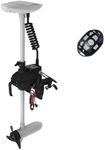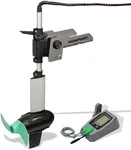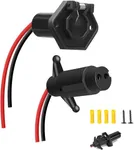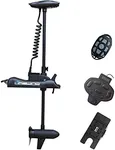Buying Guide for the Best Trolling Motors
Choosing the right trolling motor for your boat can significantly enhance your fishing experience. A trolling motor is an electric motor used to maneuver your boat quietly and precisely, which is crucial for fishing. To find the best fit for you, consider the following key specifications and how they align with your needs.ThrustThrust is the measure of how powerful the trolling motor is, usually measured in pounds (lbs). It is important because it determines how well the motor can move your boat through the water, especially in challenging conditions like strong currents or heavy winds. For small boats or kayaks, 30-40 lbs of thrust may be sufficient. Medium-sized boats may require 40-55 lbs, while larger boats might need 70 lbs or more. To pick the right thrust, consider the size and weight of your boat and the typical water conditions you will encounter.
VoltageVoltage indicates the power system of the trolling motor, commonly available in 12V, 24V, and 36V. This spec is important because it affects the motor's power and battery life. A 12V system is suitable for smaller boats and lighter use, while 24V and 36V systems provide more power and longer run times, ideal for larger boats and more demanding conditions. Choose the voltage based on your boat size and how long you plan to use the motor during your trips.
Shaft LengthShaft length is the distance from the motor head to the propeller, and it is crucial for ensuring the motor stays submerged at the right depth. If the shaft is too short, the propeller may come out of the water, while a too-long shaft can be cumbersome. For bow-mounted motors, measure the distance from the mounting point to the waterline and add 20 inches. For transom-mounted motors, measure from the top of the transom to the waterline and add 16-20 inches. Choose a shaft length that keeps the motor submerged in various water conditions.
Control TypeControl type refers to how you operate the trolling motor, with options including hand control, foot control, and remote control. This spec is important because it affects your convenience and fishing style. Hand control is straightforward and less expensive, foot control allows for hands-free operation, and remote control offers the most flexibility and ease of use. Consider your fishing habits and personal preference when choosing the control type.
Mounting LocationMounting location refers to where the trolling motor is installed on your boat, either at the bow (front) or transom (rear). This is important because it affects the boat's maneuverability and control. Bow-mounted motors provide better control and are preferred for larger boats and serious anglers, while transom-mounted motors are easier to install and suitable for smaller boats. Choose the mounting location based on your boat size and how you plan to use the motor.
Battery LifeBattery life indicates how long the trolling motor can run on a single charge, which is crucial for planning your fishing trips. It depends on the motor's power consumption and the battery capacity. Higher voltage systems (24V and 36V) generally offer longer battery life. To pick the right battery life, consider how long you typically spend on the water and whether you have access to recharge the battery during your trips.



















